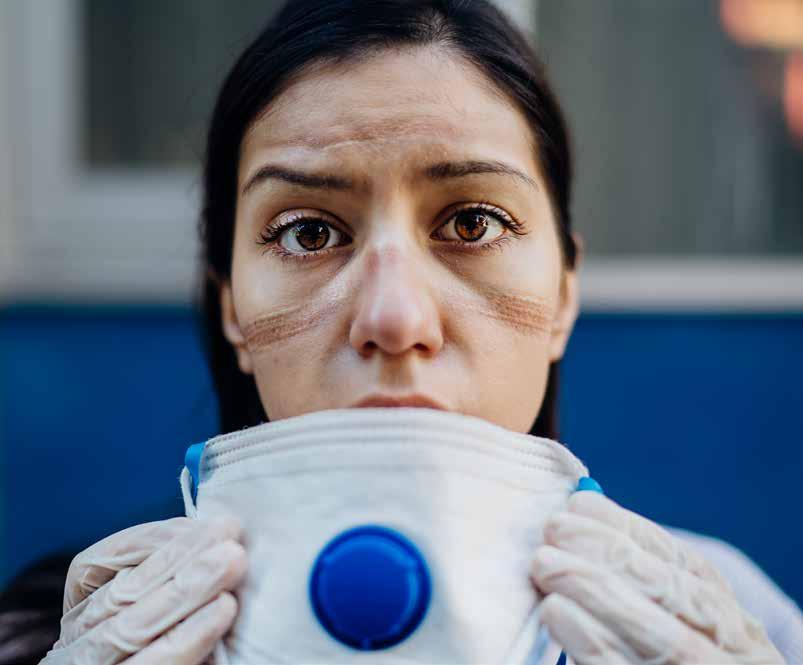
5 minute read
Nurse Resilience Through the Pandemic
BY NACHOLE JOHNSON, MSN, FNP-BC
Caring. Trustworthy. Empathetic. Problemsolver. These are all words used to describe a nurse, but there is one more word that has represented the nursing profession over the past couple of years—resilience. Of course, nurses have always demonstrated resilience, but it has never been so palpable until now. The COVID-19 pandemic has tested the resilience of nurses on the frontlines for more than two years now.
What is Nurse Resilience?
“Resilience to me was walking into the pandemic not knowing the outcome or impact it would have on patients or health care, but charging full force ahead,” says Kim Shapiro, DNP, FNPC. “We did not know how to
treat many of these patients early on, but we adapted.” The nature of nursing involves quickly adapting to rapidly changing circumstances regarding patient acuity, staffing changes, and policy. Therefore, being resourceful and adaptable is an absolute necessity as a nurse. Kelly Korb, RN, a nurse case manager for an outpatient substance use treatment program adds, it’s imperative to “be able to be flexible and a team player despite these changes.”
Shapiro and Korb are spot on regarding the critical attributes of nurse resilience. Resilience in nursing includes social support, self-efficacy, work/ life balance, practicing selfcare, having a sense of humor, optimism, and being realistic. These traits allow nurses to adapt to the stressors of the job positively. These characteristics are demonstrated when nurses are able to bounce back quickly after significant workplace stressors like the death of a patient or a worldwide pandemic.
How the Pandemic Has Tested Nurse Resiliency
During the pandemic’s peak, nurses were lauded with praise for being “heroes.” This viewpoint quickly faded as the pandemic progressed. Nurses supported those in need by being there for them even when the outcome was unknown. “Nurses worked together to get us to this point in the pandemic. We put ourselves and our families at risk working alongside the COVID population, not knowing if we were going to bring it home to our loved ones,” says Shapiro. Economic reports may present a bleak picture of
Economic reports may present a bleak picture of healthcare professionals leaving their current professions in the “Great Resignation,” but there are still nurses who thrive in their role and wouldn’t ever think of leaving.
healthcare professionals leaving their current professions in the “Great Resignation,” but there are still nurses who thrive in their role and wouldn’t ever think of leaving. Korb loves her job just as much as she did when she first became a nurse in 2013. “I love my patients. Everything I do, I do for them. They are deserving of a safe place to heal and grow in their recovery.”
While discussions on nurse resiliency pre-pandemic were typically reserved for known high-intensity areas such as critical care and the emergency room, nurses who have worked in any clinical capacity during the pandemic need support more now than ever. Nurse resiliency was tested to the breaking point for many and continues to manifest itself in multiple forms when it comes to the nursing profession. Helping nurses become more resilient in practice can help conditions that nurses are all too familiar with—burnout, stress, anxiety, and compassion fatigue.
How to Foster Resiliency in Nurses
In order for nurses to develop and sustain resiliency in today’s healthcare environment, there has to be a collective agenda among nurse leaders and institutions that employ nurses. There is no true way to estimate the depth of how the pandemic has affected—and will continue to affect—the mental health of nurses from this point forward. Resilience first needs to be acknowledged as something that can be fostered through education and support.
Developing nurse resiliency has to start within the In order for nurses to develop and sustain resiliency in today’s healthcare environment, there has to be a collective agenda among nurse leaders and institutions that employ nurses.
educational system to proactively address any mental health conditions that may develop while in clinical practice. The manner in which resiliency should be taught can be debated, but the nursing profession can model military training on the subject. Military personnel are subject to many situations that parallel nursing in stressful situations like a pandemic.
The U.S. Army developed Master Resilience Training (MRT) to foster a proactive approach to post-traumatic stress disorder (PTSD) among soldiers. Nursing leaders could develop training for both students and experienced nurses to address mental health issues related to nursing practice, including depression, PTSD, social dysfunction disorder, and anxiety. For educators to provide a more holistic approach, programs can extend training to the families of nurses. Critical elements of nurse resilience include social support and a proper work/ life balance, so it’s only natural that resilience training is extended to families of nurses.
Nurses who are active in the workforce should have continuing education to reinforce resilience training by employers to keep their staff optimistic and functioning at their best. Despite the massive impact the
pandemic has had on health care, Shapiro remains optimistic: “I don’t believe many healthcare professionals feel like we have bounced out of the pandemic yet, but I know in my heart we will.”


